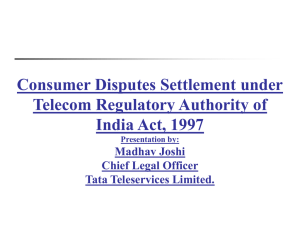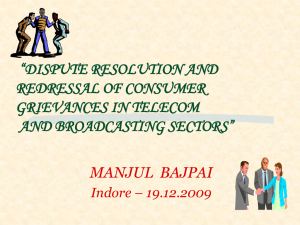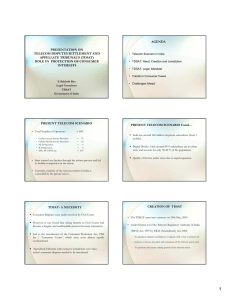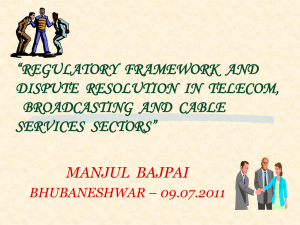Mr.S.C.khanna,Secretary General AUSPI
advertisement
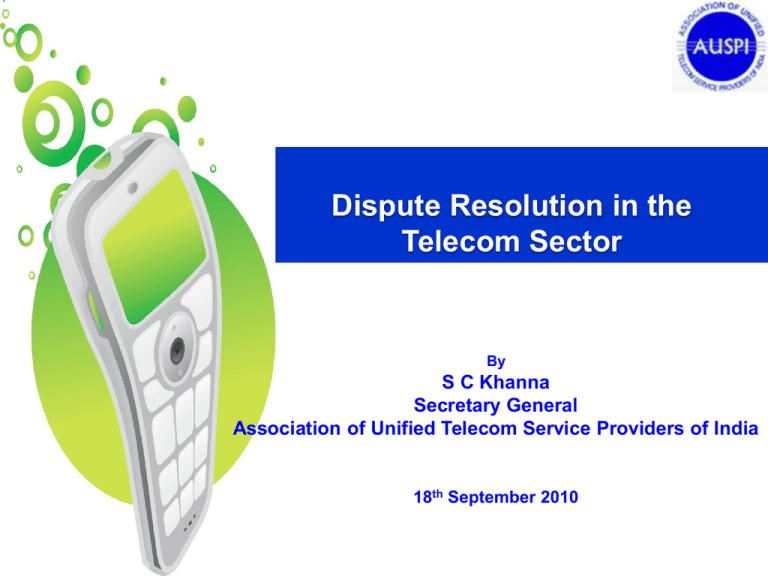
Dispute Resolution in the Telecom Sector By S C Khanna Secretary General Association of Unified Telecom Service Providers of India 18th September 2010 TELECOM SECTOR – Present Scenario The present-day telecom sector is characterized by: 700 Million Telecom Subscribers. Overall Teledensity of around 60% out of which Rural Teledensity 24.29% as compared to Teledensity 0.6% in year 1991. Second Largest Telephone Network in the World next to China One of the LOWEST Tariffs in the World due to Tough Competition among Service Providers. Simultaneous existence of state and private owned multiple operators Fast changing technologies, convergence of ideas, services markets Liberalized and customer oriented regulatory regimes. Subscribers wanting Value Added Services using IP, wireless and broadband technologies rather than Plain Old Telephony Service(POTS) Countries wanting to attract private investment by providing favourable investment climate. 2 AUSPI DISPUTE RESOLUTION – why so important ? INVESTORS Telecom sector needs huge capital investments. Investors need assurance about quick, fair and effective disputes resolution mechanism. SUBSCRIBERS Need new services at lower tariffs Delays in dispute resolution would deny them this benefit. ECONOMY Slower growth of telecom sector would retard general economic and technical development of the country. In order to avoid disruptions and delays in the development of telecom markets, disputes need to be resolved expeditiously. 3 AUSPI DISPUTE RESOLUTION – Importance Successful dispute resolution: facilitates investment climate, stimulates growth and is of prime importance to developing countries targeting higher teledensities and even spread of telecom across all the regions. is increasingly important for introducing competition should be as speedy as the networks and technologies they serve. Official dispute resolution mechanisms are important as a basic guarantee that sector policy will be implemented. TDSAT has been settling Disputes quite fast. Number of TDSAT Judgement have been in public Interest which has led to competition and reduced tariff 4 AUSPI INTERNATIONAL SCENARIO - USA FCC IS THE REGULATOR - interprets, co-ordinates and adjudicates on policy issues and disputes arising from them. FCC provides parties with a choice of ADR procedures as mandated under the Telecommunications Act of 1996. No separate appellate mechanism for telecom. FCC generally takes pro-consumer, anti-monopolistic stance in regulatory and dispute resolution functions. There is a provision of final decision to be given by a commissioner or panel of commissioners. It also admits review petitions. The decisions can be appealed in US Court of Appeal. Many of FCC orders are subject to review in Federal Courts. Unless “arbitrary and capricious” the courts generally don’t interfere in regulatory decisions. 6 AUSPI INNOVATIVE INDIAN STRUCTURE India has perhaps a unique model since year 2000 Regulatory functions are vested with the telecom regulator Telecom Regulatory Authority of India (TRAI), Policy and licensing functions are retained by the Union Government’s wing Department of Telecommunications (DoT), Adjudication function has been vested with a specialized high powered tribunal Telecom Disputes Settlement & Appellate Tribunal (TDSAT). TDSAT in India is the ONLY Tribunal of its kind in the World. 7 AUSPI TDSAT – a one stop Solution By TRAI Act, which is a special Act, Jurisdiction of civil courts has been ousted and for all telecom, cable and broadcasting sector related disputes, the jurisdiction has been vested only with TDSAT. High courts entertain telecom disputes if TDSAT is not sitting. HC has limited jurisdiction under Art 226 of constitution to correct gross errors of jurisdiction. TDSAT has the following powers i.e. to (a) adjudicate any dispute – (i) between a licensor and a licensee; (ii) between two or more service providers; (iii) between a service provider and a group of consumers (b) hear and dispose of appeal against any direction, decision or order of the Telecom Regulatory Authority of India. 8 AUSPI TDSAT Jurisdiction TDSAT does not hear individual consumer Consumer Group can however approach TDSAT. complaints. SUPREME COURT• WLL Case- TDSAT powers are not limited to judicial review. It is creature of statute-an expert body created to determine correctness of an order passed by another expert body. 9 AUSPI TDSAT - Its Different ! It has wide original and appellate jurisdiction. As the only telecom adjudicator, it hears questions of facts and law. It blends law, commerce and technology. Chairperson - serving or retired judge of Supreme Court or Chief Justice of a High Court. Two members - well versed with technology, telecommunication, industry, commerce or administration or Secretary to Union of India for 2 years minimum. It can regulate its own procedures. Appeal lies only to the highest court i.e., Supreme Court of India. 10 AUSPI TDSAT - overcomes disadvantages of Regulatory Adjudication It has gathered required expertise. Very few matters are pending. It passed orders on interconnection issues, license agreement interpretation, pricing, jurisdictional issues, policy interpretation, level playing field. Even complex matters like challenge to limited mobility service reached finality in less than 3 years, despite appeal to Supreme court. 11 AUSPI 12 AUSPI
